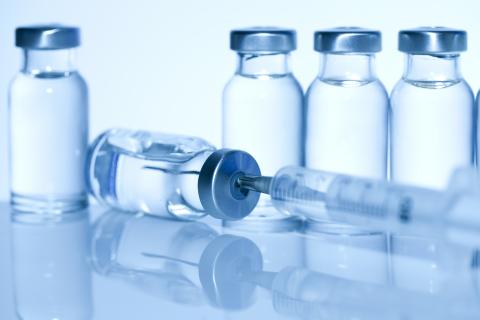
EVAC: How a novel material turned into a major discovery for improved vaccines
EVAC (French initials for Formulation of a New Vaccine Adjuvant) is a project for the development of a new vaccine adjuvant from the Institut Lavoisier de Versailles (ILV - Univ. Paris-Saclay, UVSQ, CNRS), supported by SATT Paris-Saclay. It lies at the roots of the discovery of a better immune response of vaccines.
The EVAC project aims to design a resorbable vaccine adjuvant for so-called "killed" vaccines. Their antigens - i.e. proteins, macromolecules, viruses and inactivated bacteria - which trigger an immune response when recognised by the body, require an adjuvant to be effective. The adjuvant is indeed essential in order to trigger a strong and lasting immune response. In the vast majority of vaccines on the market, the adjuvant is aluminium salts. Although this has an excellent benefit/risk ratio, aluminium salts nevertheless have some limitations. The first is that the salts do not degrade and therefore leave indelible deposits at the injection site: internal tattoos. This is a source of public distrust, as it is feared to be the cause of the development of certain pathologies, such as encephalitis. "These beliefs are unfounded because very high doses would have to be inoculated to generate such diseases, yet killed vaccines contain only a tiny amount," insists Clémence Sicard, a lecturer from the Molecules, Interactions, Materials (MIM) team at the Institut Lavoisier de Versailles and leader of the EVAC project. The second is that, for reasons of chemical compatibility, these adjuvants cannot be used for all antigens.
An idea born of a chance meeting
In 2018, Clémence Sicard was informally speaking of her research on Metal-Organic Frameworks (MOFs), some of which are aluminium-based, with Jacques Cohen, an immunology researcher and professor emeritus at the University of Reims Champagne-Ardenne. At the time, her work was focused on the creation of biohybrid materials for biocatalysis projects, particularly for pollution control use. The two scientists saw that aluminium-based materials are a major concern in the improvement of killed vaccines. Together, they saw a tremendous research opportunity, and in 2019, filed a premature project with SATT Paris-Saclay. Called EVAC, the project involved the development of a new adjuvant that would no longer suffer from the constraints of aluminium. Deemed to have a significant impact on improving immunisation coverage, it has been supported since 2020 and started in June in that same year. Within this framework, a proof of concept, which includes tests on mice, was carried out. The vaccine formulation created is not only gradually degraded in the body but also generates an immune response before it is dissolved.
An adjuvant with a novel composition
The new adjuvant contains an aluminium-based MOF. It is a porous, crystallised and hybrid material, i.e. composed of an inorganic part (aluminium) and an organic part. In a physiological environment, the structure of the MOF is progressively altered by the dissociation of the bond between the organic and inorganic parts of the material. It is this characteristic that makes it possible to degrade the material, which is then completely eliminated. "We have not observed any storage of aluminium in mice when this component is inoculated into them," says Clémence Sicard.
An unexpected discovery
The experience was also an opportunity to make a major and unexpected discovery. "At the end of these tests, we got a fantastic surprise: our adjuvant also made it possible to have a better immune response, and therefore a better efficiency of the killed vaccines!" says the researcher enthusiastically. Indeed, the new vaccine formulation achieves, in some cases, a 300% greater response than standard aluminium. It is also stable for twenty-four months with no need for the addition of preservatives. "This is a requirement for vaccines, but it's not easy to develop," says Clémence Sicard. In the end, the process developed is simple, inexpensive and easy to scale up.
Hypothesis confirmed
On the strength of this success, the team filed a patent application and submitted a maturation project to SATT Paris-Saclay, which was awarded in January 2021. This renewed support gave them the opportunity to test the adjuvant beyond tetanus toxoid - a model antigen used in the tetanus vaccine, which was initially tested - on other types of antigens such as bacteria, viruses, sugars and nucleic acids, in order to expand the scope of the research. "All the results confirm our hypotheses: the immune response is greatly improved," summarises Clémence Sicard.
The value of EVAC in the industrial field
These performances led the team to initiate discussions with potential partners in the human and animal health industry in 2021, in order to validate the suitability of the new adjuvant with their products. "We were accompanied in this process by the SATT, without which nothing would have been possible," recalls the researcher. This is because developing the project in the industrial field requires knowledge of business, negotiation, law, regulations, and also industrial development, none of which fall within the scientific scope. To date, although the possibility of creating a start-up has not been excluded, the path of technology transfer is favoured. Agreements could be finalised by the end of 2023.
Acknowledgement and great ambitions
In recognition of her work, including EVAC, Clémence Sicard was appointed to the Institut Universitaire de France in September 2022. This made it possible for her to reduce her teaching obligations for five years, i.e. research time to carry out an ambitious scientific project. "I am honoured and delighted to be given this opportunity, which will help me enormously in pursuing the EVAC project, among other things, especially as there are still many possible developments of this technology.” For example, she plans to do research in immune response orienters, which, when coupled with an antigen, provide new perspectives for preventing certain pathogens or infections.
